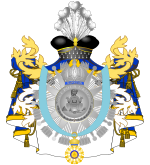Gaspard Monge
Gaspard Monge, Count of Peluse (May 9, 1746 – July 28, 1818), was a French mathematician, inventor of descriptive geometry.
Biography
He was born in Beaune the son of Jacques Monge, a peddler who later became president of the Beaune guild of haberdashery, and Jeanne Rousseaux. He studied at the Beaune and Lyon schools and at the Mézières military school. At the age of 16 he was appointed professor of physics at Lyon, a post he held until 1765. Three years later he was professor of mathematics and in 1771 professor of physics at Mézières. He entered the Royal Academy of Sciences in 1780 and published eight years later his Traité de statique.
Already one of the most important scientists in his country, the French Revolution, which he strongly supported from its inception in 1789, completely changed the course of his life. First a member of the Patriotic Society, he later joined the Jacobins, where he met Robespierre and Saint-Just among other notorious revolutionaries. He was elected Vice President on the eve of 9 Thermidor (July 27, 1794).
In 1792 he was made with five others (Danton was among them) a member of the Provisional Executive of the Council. Appointed Minister of the Navy (from August 1792 to April 1793) by the Convention, he was asked to reorganize the arsenals and strengthen the cannon factories. He helped found the École Polytechnique in 1794, where he taught descriptive geometry for more than ten years. He entered the Institute of France (1795). While looking for works of art during the campaign in Italy, he met Napoleon, who commissioned him, along with Claude Louis Berthollet, to bring the ratification of the Treaty of Campo Formio to the Directory.
On February 6, 1798, he left Paris for Rome, with the order to meet with Pope Pius VI on behalf of the French Republic, ordering him to renounce his temporal authority, retaining only his spiritual authority. Knowing that the proposal was unrealizable, he ordered the pontiff to leave Rome in two days: Pius VI left the city during the night of February 19-20, 1798. After the abuses of General André Masséna and his dismissal (the March 2, 1798), Monge named the posts of the new "Roman Republic" except for finances.
He is invited to participate in the expedition to Egypt, but claims that he is too old to participate in this enterprise. However, Napoleon manages to persuade him and changes his mind. He became one of the young general's confidants in Egypt, being named the first president of the Egyptian Institute founded in August 1798. In addition, he prepared a paper on mirages during his stay in the East.
He returned to France with Napoleon on August 23, 1799, the year he published his famous work Geometrie descriptive. He was made a member of the Senate, director of the Polytechnic School (1802) and Count of Pelusio. The fall of Napoleon causes him to be excluded from the Institute and the Polytechnic School.
He married Marie-Catherine Huart (1747-1846) in 1777, with whom he had three daughters. He died in Paris on July 28, 1818 of natural causes and was buried in the Père-Lachaise cemetery. In 1989, his ashes were transferred to the Panthéon in Paris.
Descriptive geometry
Monge is considered the inventor of descriptive geometry, a system that allows three-dimensional surfaces of objects to be represented on a two-dimensional surface. There are different representation systems that serve this purpose, such as conical perspective, the system of bounded planes, etc. but perhaps the most important is the dihedral system, also known as the Monge system, which was developed by Monge in his first publication in 1799.
Work
- I brought himementaire de statique. Paris 8. A., 1810
- Géométrie descriptive. Paris 7. A., 1799
- Application de l'analyse à la géométrie. Paris 5. A., 1850
- Application de l'algèbre à la géométrie. 1805
Acknowledgments
- Grand Cross of the Order of the Meeting.
- Great Honor Legion Officer.
- Knight of the Order of the Iron Crown.
- His hometown, Beaune, dedicated him a statue in 1849.
- It is one of 72 scientists whose name is registered at the Eiffel Tower.
- The lunar crater Monge was named in 1935.
- Since 4 November 1992, the French Navy operates the ship MRIS FS Mongeso named in his honor.
- The asteroid (28766) Monge, discovered by Paul G. Comba in 2000 also bears its name.
Coat of arms
| Figure | Description |
| Guns of the Earl of Péluse and the Empire On gold, a siple palm on a field of the same color; with the emblem of the Condes-Senadores in the upper left of the shield.·· |
Contenido relacionado
Positron
Michelia
Applied botany





